A Case Study on the Energy Capacity of a Flexible Rockfall Barrier in Resisting Landslide Debris
Abstract
:1. Introduction
2. Open Hillside Landslide in Chongqing, China
2.1. Field Investigation
2.2. Back-Analysis of the Landslide and Flexible Barrier Interaction
2.2.1. Modeling of the Landslide Debris
2.2.2. Modeling of the Flexible Barrier
2.2.3. Modeling of the Interaction
2.3. Mobility of the Landslide
2.4. Response of the Flexible Barrier
2.4.1. Internal Forces of the Ropes
2.4.2. Elongation of Brake Rings
3. Numerical Parametric Study of the Flexible Barrier Subjected to Landslide Debris
3.1. Model Description
3.2. Results of the Parametric Study
3.2.1. Elongation of the Brake Rings
3.2.2. Energy Dissipating Distribution
3.2.3. Energy Dissipation Ratio of the Brake Rings
4. Conclusions
- The total energy of landslide debris dissipated by a flexible barrier is less than 40%, most of the energy is dissipated by friction and internal energy.
- The energy dissipation ratio of a flexible barrier decreases linearly with the increase of the impact energy.
- The maximum energy capacity of a flexible barrier subjected to landslide debris is controlled by the lower support rope. The maximum energy capacity of a flexible rockfall barrier in resisting landslide debris is four-times that of resisting a rockfall.
Author Contributions
Funding
Institutional Review Board Statement
Informed Consent Statement
Data Availability Statement
Acknowledgments
Conflicts of Interest
References
- Zhang, Y.; Shen, C.; Zhou, S.; Luo, X. Analysis of the influence of forests on landslides in the Bijie area of Guizhou. Forests 2022, 13, 1136. [Google Scholar] [CrossRef]
- Grima, N.; Edwards, D.; Edwards, F.; Petley, D.; Fisher, B. Landslides in the Andes: Forests can provide cost-effective landslide regulation services. Sci. Total Environ. 2020, 745, 141128. [Google Scholar] [CrossRef] [PubMed]
- Schmaltz, E.M.; Steger, S.; Glade, T. The influence of forest cover on landslide occurrence explored with spatio-temporal information. Geomorphology 2017, 290, 250–264. [Google Scholar] [CrossRef]
- Griffiths, J.W.; Lukens, C.E.; May, R. Increased forest cover and limits on clear-felling could substantially reduce landslide occurrence in Tasman, New Zealand. New Zealand. J. For. Sci. 2020, 50, 1–13. [Google Scholar] [CrossRef]
- Huang, R.Q.; Fan, X.M. The landslide story. Nat. Geosci. 2013, 6, 325–326. [Google Scholar] [CrossRef]
- Cui, P.; Chen, X.Q.; Zhu, Y.Y.; Su, F.H.; Wei, F.Q.; Han, Y.S.; Liu, H.J.; Zhuang, J.Q. The Wenchuan Earthquake (May 12, 2008), Sichuan Province, China, and resulting geohazards. Nat. Hazards 2011, 56, 19–36. [Google Scholar] [CrossRef]
- Grassl, H.; Bartelt, P.A.; Volkwein, A.; Wartmann, S. Experimental and Numerical Modeling of Highly Flexible Rockfall Protection Barriers; Soil and Rock America: Cambridge, MA, USA, 2003. [Google Scholar]
- Boetticher, A.V.; Volkwein, A. Numerical modelling of chain-link steel wire nets with discrete elements. Can. Geotech. J. 2018, 56, 398–419. [Google Scholar] [CrossRef]
- Available online: https://weibo.com/2615417307/Lwajt7Tto (accessed on 4 June 2022).
- Yang, J.; Duan, S.; Li, Q.; Liu, C.Q. A review of flexible protection in rockfall protection. Nat. Hazards 2019, 99, 71–89. [Google Scholar] [CrossRef]
- Castro-Fresno, D.; Luis, L.Q.; Bianco-Fernandez, E.; Zamora-Barraza, D. Design and evaluation of two laboratory tests for the nets of a flexible anchored slope stabilization system. Geotech. Test. J. 2009, 32, 315–324. [Google Scholar]
- Zhu, Z.H.; Yin, J.H.; Qin, J.Q.; Tan, D.Y. A new discrete element model for simulating a flexible ring net barrier under rockfall impact comparing with large-scale physical model test data. Comput. Geotech. 2019, 116, 103208. [Google Scholar] [CrossRef]
- Qin, J.Q.; Yin, J.H.; Zhu, Z.H.; Tan, D.Y. Development and application of new FBG mini tension link transducers for monitoring dynamic response of a flexible barrier under impact loads. Measurement 2020, 153, 107409. [Google Scholar] [CrossRef]
- Gentilini, C.; Govoni, L.; Miranda, S.D.; Gottardi, G.; Ubertini, F. Three-dimensional numerical modelling of falling rock protection barriers. Comput. Geotech. 2012, 44, 58–72. [Google Scholar] [CrossRef]
- Glover, J.; Denk, M.; Bourrier, F.; Volkwein, A.; Gerber, W. Measuring the kinetic energy dissipation effects of rock fall attenuating systems with video analysis. Proc. Interpraevent Congr. 2012, 1, 151–160. [Google Scholar]
- Cui, L.M.; Shi, S.Q.; Wang, M.; Wang, W.K. Research on the impact protection performance of the rockfall attenuator system under multiposition distributed counterweights conditions. Chin. J. Rock Mech. Eng. 2019, 38, 332–342. [Google Scholar]
- Duffy, J.D.; DeNatale, J.S. Debris flow mitigation using flexible barriers. In Proceedings of the 47th Annual Highway Geology Symposium, Cody, WY, USA, 6–9 September 1996. [Google Scholar]
- Wendeler, C.; Volkwein, A.; Roth, A.; Denk, M.; Wartmann, S. Field measurements used for numerical modelling of flexible debris flow barriers. In Proceedings of the International Conference on Debris-Flow Hazards Mitigation: Mechanics, Prediction, and Assessment, Chengdu, China, 10–13 September 2007. [Google Scholar]
- Bugnion, L.; McArdell, B.W.; Bartelt, P.; Wendeler, C. Measurements of hillslope debris flow impact pressure on obstacles. Landslides 2012, 9, 179–187. [Google Scholar] [CrossRef]
- Roberto, B.; Andrea, S.; Anna, M.F. Debris flow hazard mitigation: A simplified analytical model for the design of flexible barriers. Comput. Geotech. 2013, 54, 1–15. [Google Scholar]
- Tan, D.Y.; Yin, J.H.; Feng, W.Q.; Qin, J.Q.; Zhu, Z.H. Large-scale physical modelling study of a flexible barrier under the impact of granular flows. Nat. Hazards Earth Syst. Sci. 2018, 18, 2625–2640. [Google Scholar] [CrossRef]
- Tan, D.Y.; Yin, J.H.; Feng, W.Q.; Zhu, Z.H.; Qin, J.Q.; Chen, W.B. New simple method for calculating impact force on flexible barrier considering partial muddy debris flow passing through. J. Geotech. Geoenviron. 2019, 145, 04019051. [Google Scholar] [CrossRef]
- Canelli, L.; Ferrero, A.M.; Migliazza, M.; Segalini, A. Debris flow risk mitigation by the means of rigid and flexible barriers-experimental tests and impact analysis. Nat. Hazards Earth Sys. Sci. 2012, 12, 1693–1699. [Google Scholar] [CrossRef]
- Wendeler, C.; Volkwein, A. Laboratory tests for the optimization of mesh size for flexible debris-flow barriers. Nat. Hazards Earth Sys. Sci. 2015, 15, 2597–2604. [Google Scholar] [CrossRef]
- Ng, C.W.W.; Song, D.; Choi, C.E.; Koo, R.C.H.; Kwan, J.S.H. A novel flexible barrier for landslide impact in centrifuge. Geotech. Lett. 2016, 6, 221–225. [Google Scholar] [CrossRef]
- Song, D. Mechanisms of Debris Flow Impact on Rigid and Flexible Barriers; The Hong Kong University of Science and Technology: Hong Kong, China, 2016. [Google Scholar]
- Jiang, R.; Fei, W.P.; Zhou, H.W.; Huo, M.; Zhou, J.W.; Wang, J.M.; Wu, J.J. Experimental and numerical study on the load and deformation mechanism of a flexible net barrier under debris flow impact. B Eng. Geol. Environ. 2020, 79, 2213–2233. [Google Scholar] [CrossRef]
- Volkwein, A. Numerical simulation of flexible rockfall protection systems. In Proceedings of the ASCE International Conference on Computing in Civil Engineering, Cancun, Mexico, 12–15 July 2005; pp. 1285–1295. [Google Scholar]
- Chan, S.L.; Zhou, Z.H.; Liu, Y.P. Numerical analysis and design of flexible barriers allowing for sliding nodes and large deflection effects. In Proceedings of the One Day Seminar on Natural Terrain Hazard Mitigation Measures, Hong Kong, China, 16 October 2012. [Google Scholar]
- Boetticher, A.V.; Volkwein, A.; Wüchner, R.; Bletzinger, K.; Wendeler, C. Numerical modeling of shallow landslide impacts on flexible protection systems and its validation with full scale testing. In Proceedings of the IV International Conference on Computational Methods for Coupled Problems in Science and Engineering, Kos, Greece, 20–22 June 2011. [Google Scholar]
- Li, X.; Zhao, J. A unified CFD-DEM approach for modeling of debris flow impacts on flexible barriers. Int. J. Numer. Anal. Methods Geomech. 2018, 42, 1643–1670. [Google Scholar]
- Leonardi, A.; Wittel, F.K.; Mendoza, M.; Vetter, R.; Herrmann, H.J. Particle-Fluid-Structure interaction for debris flow impact on flexible barriers. Comput-Aided Civ. Inf. 2016, 31, 323–333. [Google Scholar] [CrossRef]
- Cheung, A.K.C.; Yiu, J.; Lam, H.W.K.; Sze, E.H.Y. Advanced numerical analysis of landslide debris mobility and barrier interaction. HKIE Trans. 2018, 25, 76–89. [Google Scholar] [CrossRef]
- Kwan, J.S.H.; Chan, S.L.; Cheuk, J.C.Y.; Koo, R.C.H. A case study on an open hillside landslide impacting on a flexible rockfall barrier at Jordan Valley, Hong Kong. Landslides 2014, 11, 1037–1050. [Google Scholar] [CrossRef]
- Zhao, L.; He, J.W.; Yu, Z.X.; Liu, Y.P.; Zhou, Z.H.; Chan, S.L. Coupled numerical simulation of a flexible barrier impacted by debris flow with boulders in front. Landslides 2020, 17, 2723–2736. [Google Scholar] [CrossRef]
- Albaba, A. Discrete element modeling of the impact of granular debris flows on rigid and flexible structures. Ph.D. Thesis, Université Grenoble Alpes, Grenoble, France, 2015. [Google Scholar]
- Ceccato, F.; Redaelli, I.; di Prisco, C.; Simonini, P. Impact forces of granular flows on rigid structures: Comparison between discontinuous (DEM) and continuous (MPM) numerical approaches. Comput. Geotech. 2018, 103, 201–217. [Google Scholar] [CrossRef]
- Wendeler, C.; Volkwein, A.; McArdell, B.W.; Bartelt, P. Load model for designing flexible steel barriers for debris flow mitigation. Can. Geotech. J. 2018, 39, 1–18. [Google Scholar] [CrossRef]
- Poudyal, S.; Choi, C.E.; Song, D.; Zhou, G.G.D.; Yune, C.Y.; Cui, Y.; Leonardif., A.; Busslingerg, M.; Wendeler, C.; Piton, G.; et al. Review of the mechanisms of debris-flow impact against barriers. In Debris-Flow Hazards Mitigation: Mechanics, Monitoring, Modeling, and Assessment, Proceedings of the 7th International Conference on Debris-Flow Hazards Mitigation, Golden, Colorado, CO, USA, 10–13 June 2019; Association of Environmental and Engineering Geologists: Brunswick, OH, USA, 2019. [Google Scholar]
- Gentilini, C.; Gottardi, G.; Govoni, L.; Mentani, A.; Ubertini, F. Design of falling rock protection barriers using numerical models. Eng. Struct. 2013, 50, 96–106. [Google Scholar] [CrossRef]
- Koo, R.C.H.; Kwan, J.S.H.; Lam, C.; Ng, C.W.W.; Yiu, J.; Choi, C.E.; Ng, A.K.L.; Ho, K.K.S.; Pun, W.K. Dynamic response of flexible rockfall barriers under different loading geometries. Landslides 2017, 14, 905–916. [Google Scholar] [CrossRef]
- Yu, Z.X.; Zhao, L.; Liu, Y.P.; Zhao, S.C.; Xu, H.; Chan, S.L. Studies on flexible rockfall barriers for failure modes, mechanisms and design strategies: A case study of Western China. Landslides 2019, 16, 347–362. [Google Scholar] [CrossRef]
- Wartmann, S.; Salzmann, H. Debris flow and floating tree impacts on flexible barriers. In Proceedings of the Conference on Natural Terrain—A Constraint to Development, Hong Kong, China, 14 November 2002; Institution of Mining and Metallurgy: Branch, Hong Kong, 2002. [Google Scholar]
- Roth, A.; Kästli, A.; Frenez, T. Debris flow mitigation by means of flexible barriers. In Proceedings of the International Symposium Interpraevent 2004, Trento, Italy, 24–27 May 2004. [Google Scholar]
- GEO. Guidelines on Empirical Design of Flexible Barriers for Mitigating Natural Terrain Open Hillslope Landslide Hazards, (Technical Guidance Note No. 37); Geotechnical Engineering Office, HKSAR Government: Hong Kong, China, 2014.
- Song, D.; Zhou, G.G.D.; Xu, M.; Choi, C.E.; Li, S.; Zheng, Y. Quantitative analysis of debris-flow flexible barrier capacity from momentum and energy perspectives. Eng. Geol. 2019, 251, 81–92. [Google Scholar] [CrossRef]
- EOTA. Falling Rock Protection Kits. EAD 340059-00-0106. European Organization for Technical Approvals, July. 2018. Available online: https://www.nlfnorm.cz/en/ehn/6332 (accessed on 21 July 2022).
- Xu, H.; Gentilini, C.; Yu, Z.X.; Qi, X.; Zhao, S.C. An energy allocation based design approach for flexible rockfall protection barriers. Eng. Struct. 2018, 173, 831–852. [Google Scholar] [CrossRef]
- Volkwein, A.; Gerber, W.; Klette, J.; Spescha, G. Review of approval of flexible rockfall protection systems according to ETAG 027. Geosciences 2019, 9, 49. [Google Scholar] [CrossRef] [Green Version]
- Crosta, G.B.; Imposimato, S.; Roddeman, D.G. Numerical modelling of large landslides stability and runout. Nat. Hazards Earth Sys. Sci. 2010, 3, 523–538. [Google Scholar] [CrossRef] [Green Version]
- LS-Dyna Theory Manual; Livermore Software Technology: California, CA, USA, 2006.
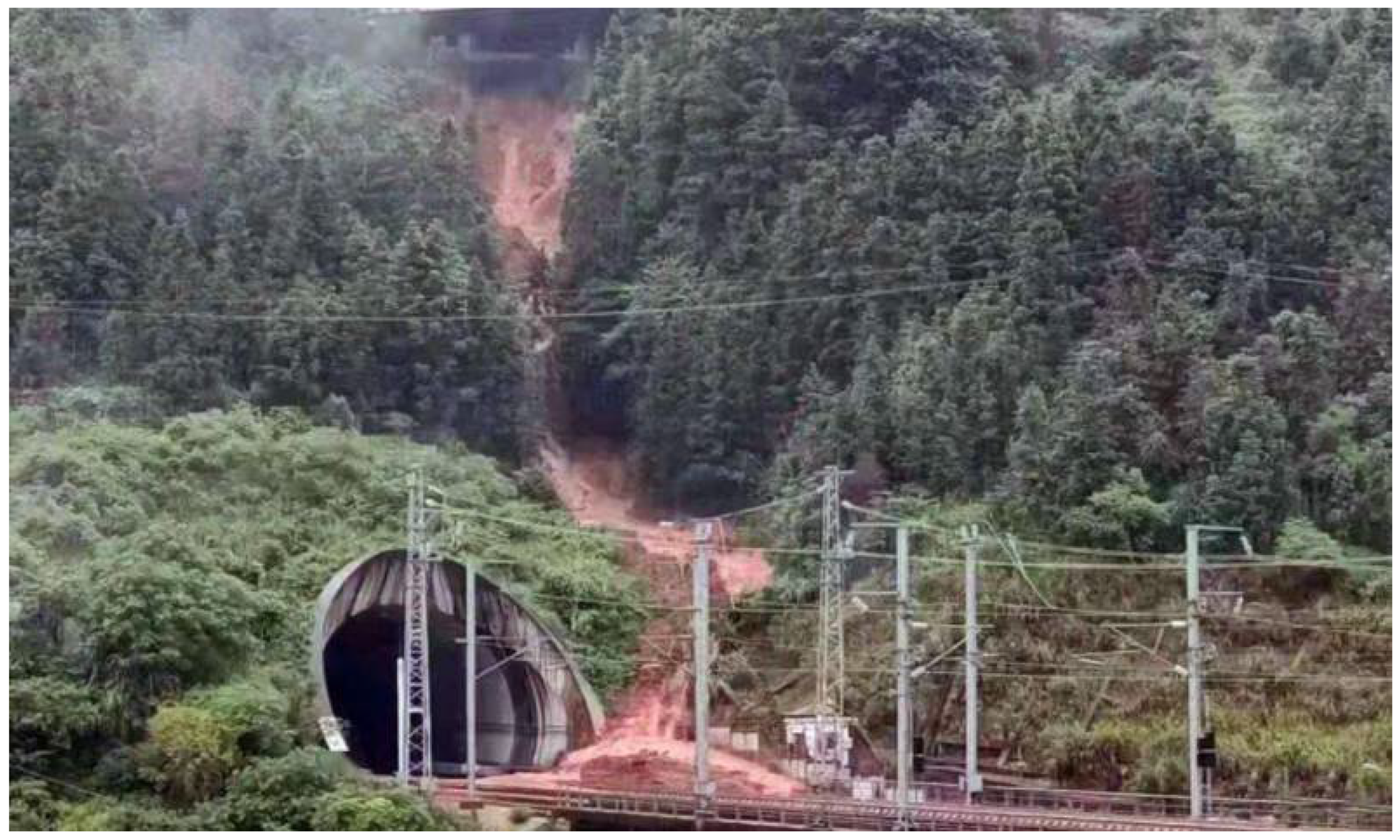
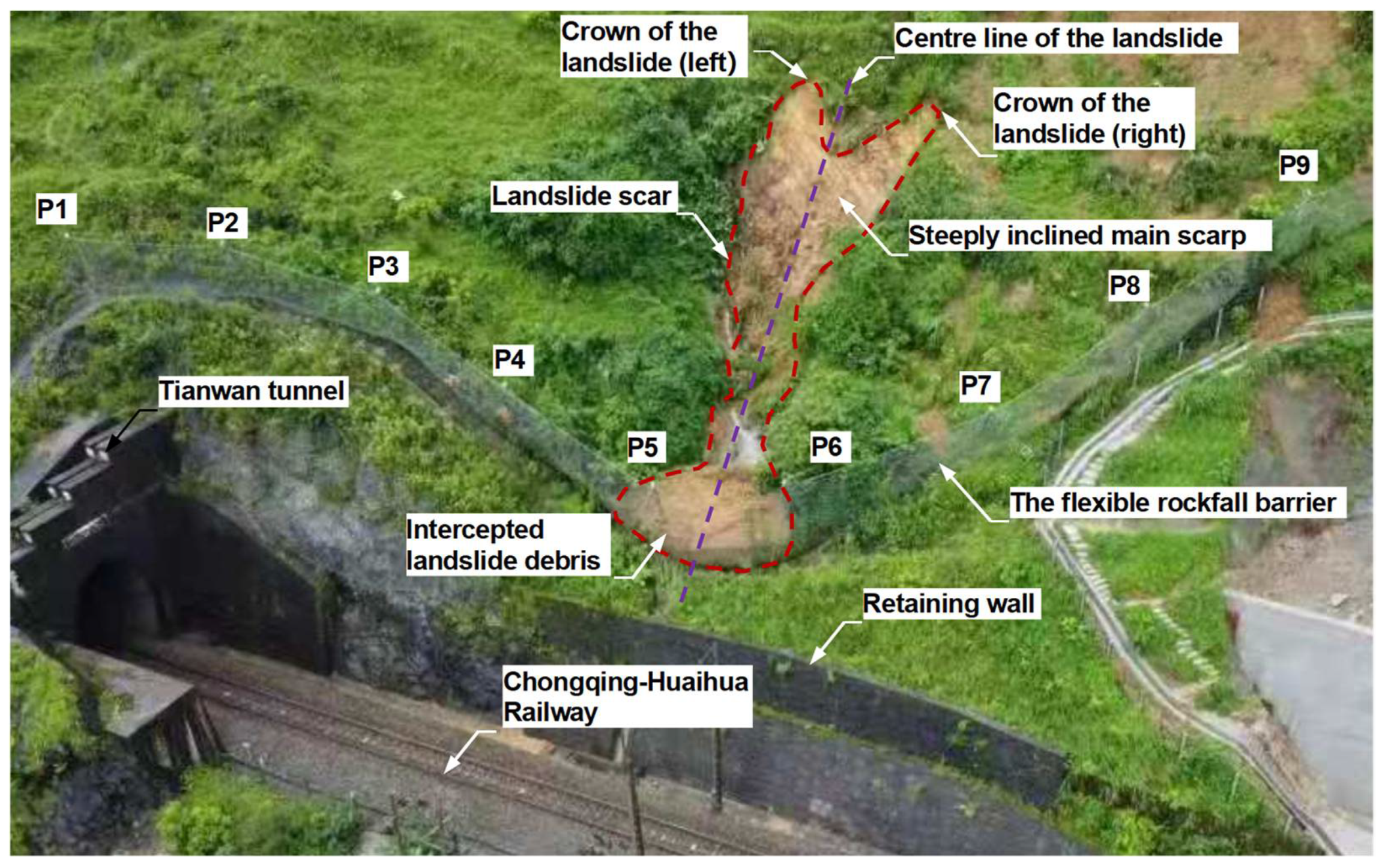
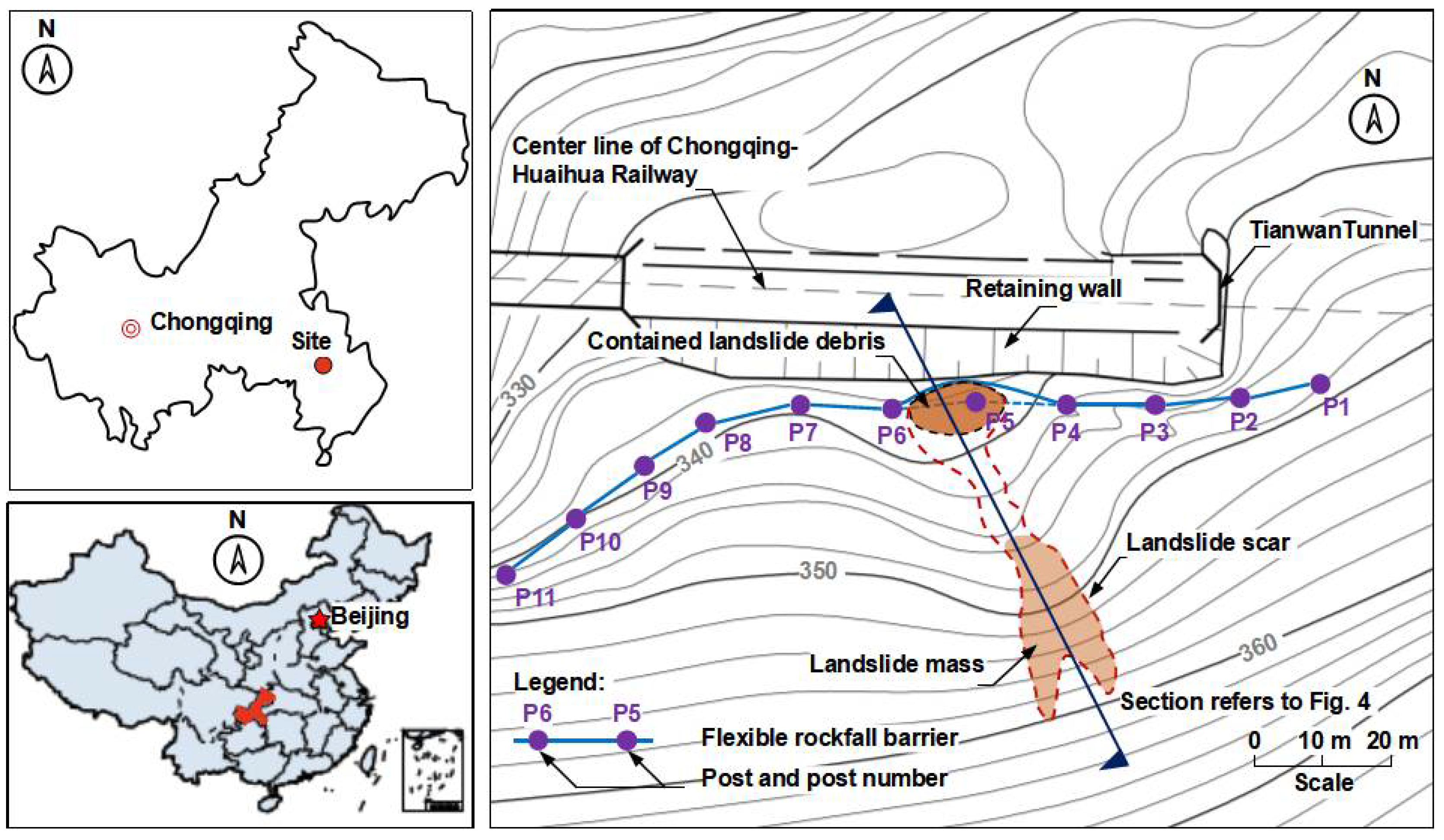
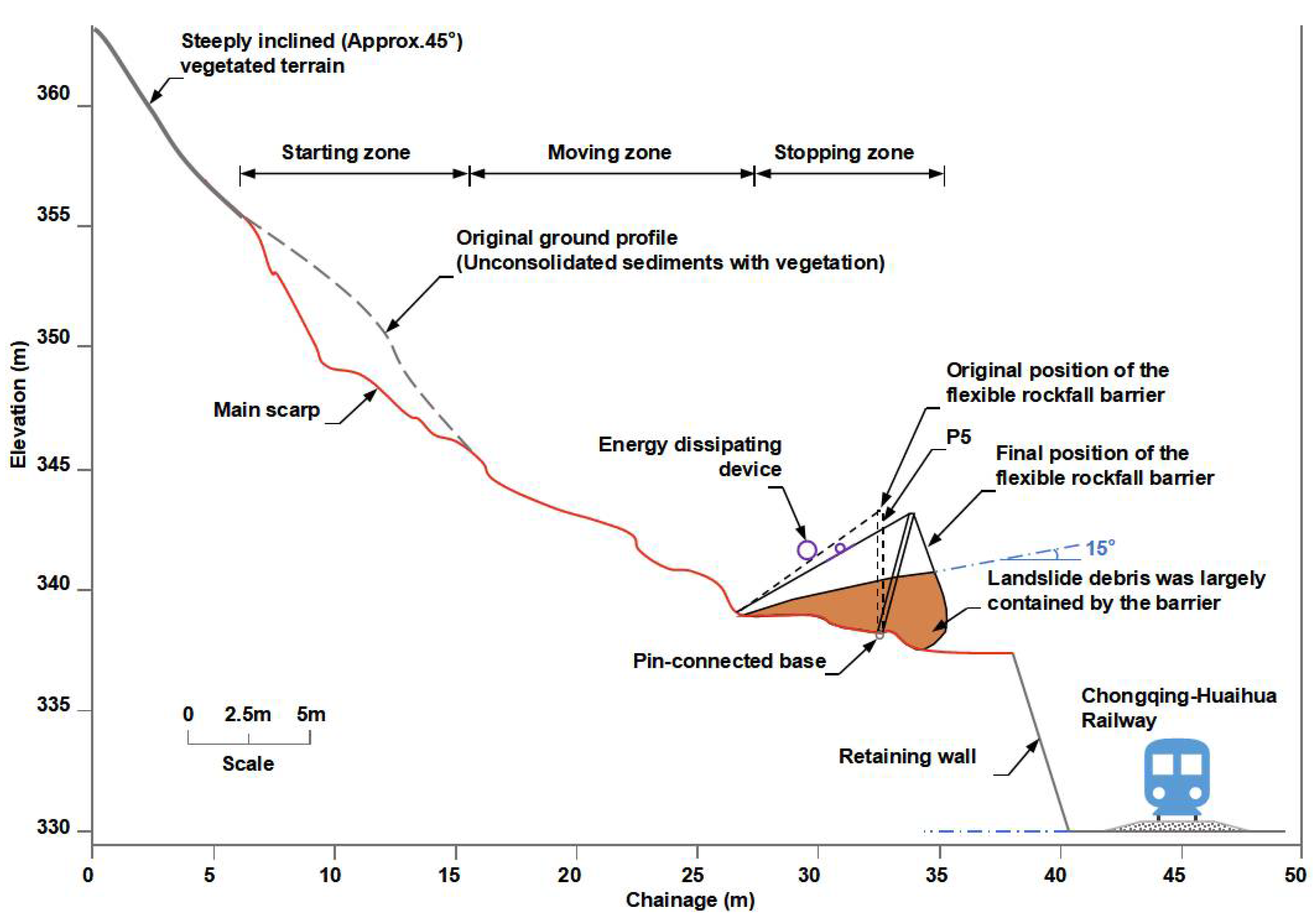
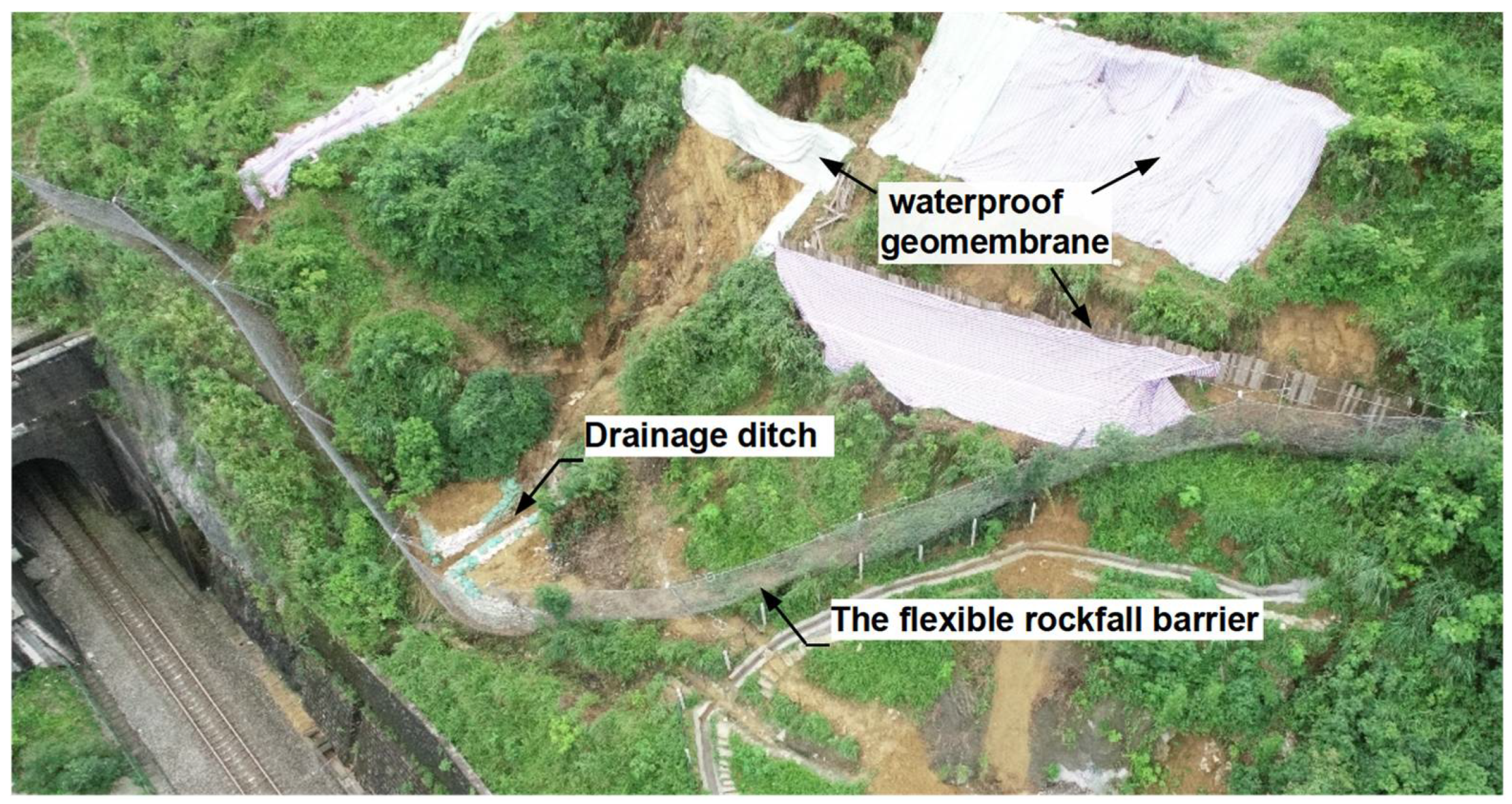
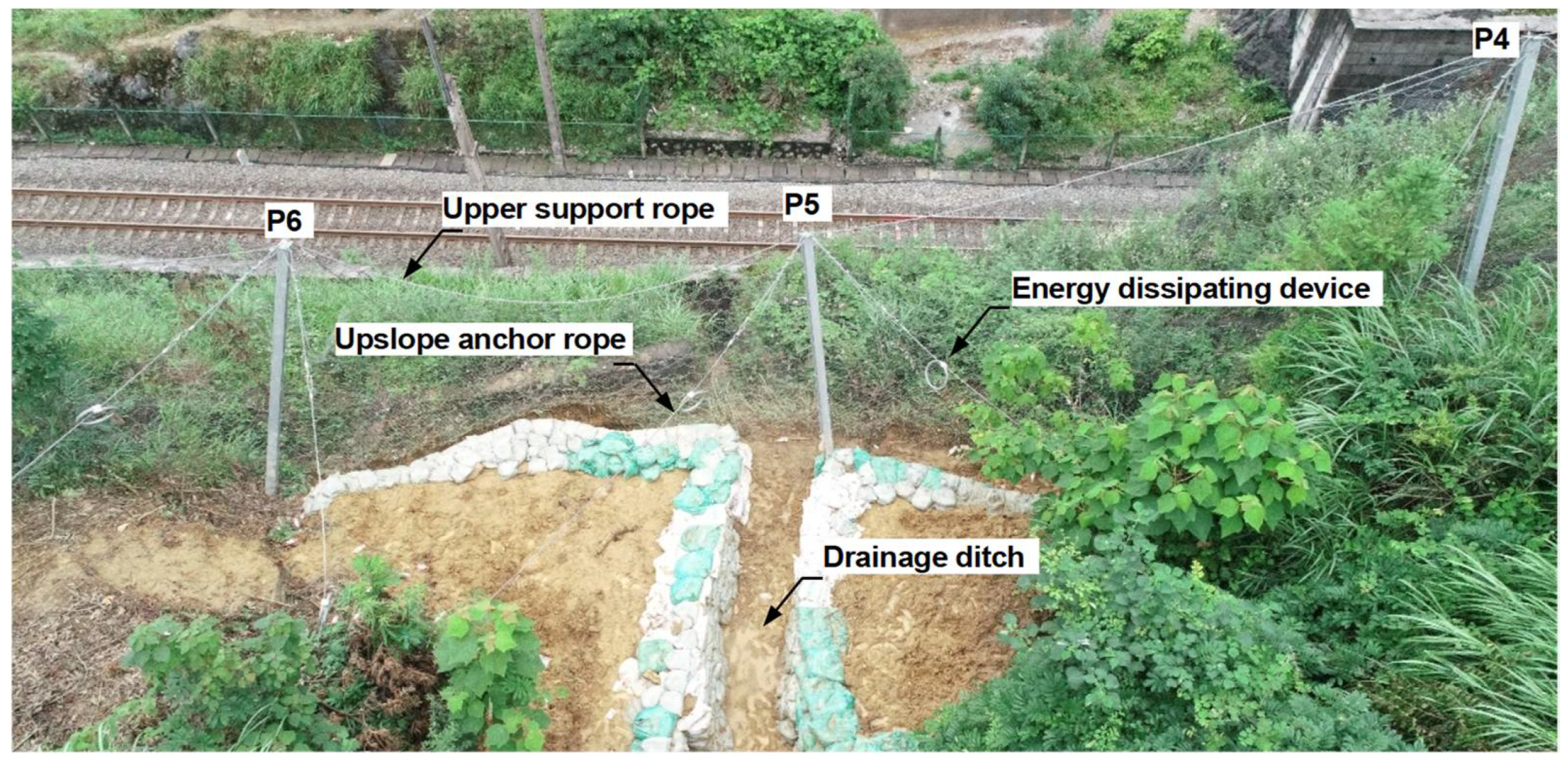

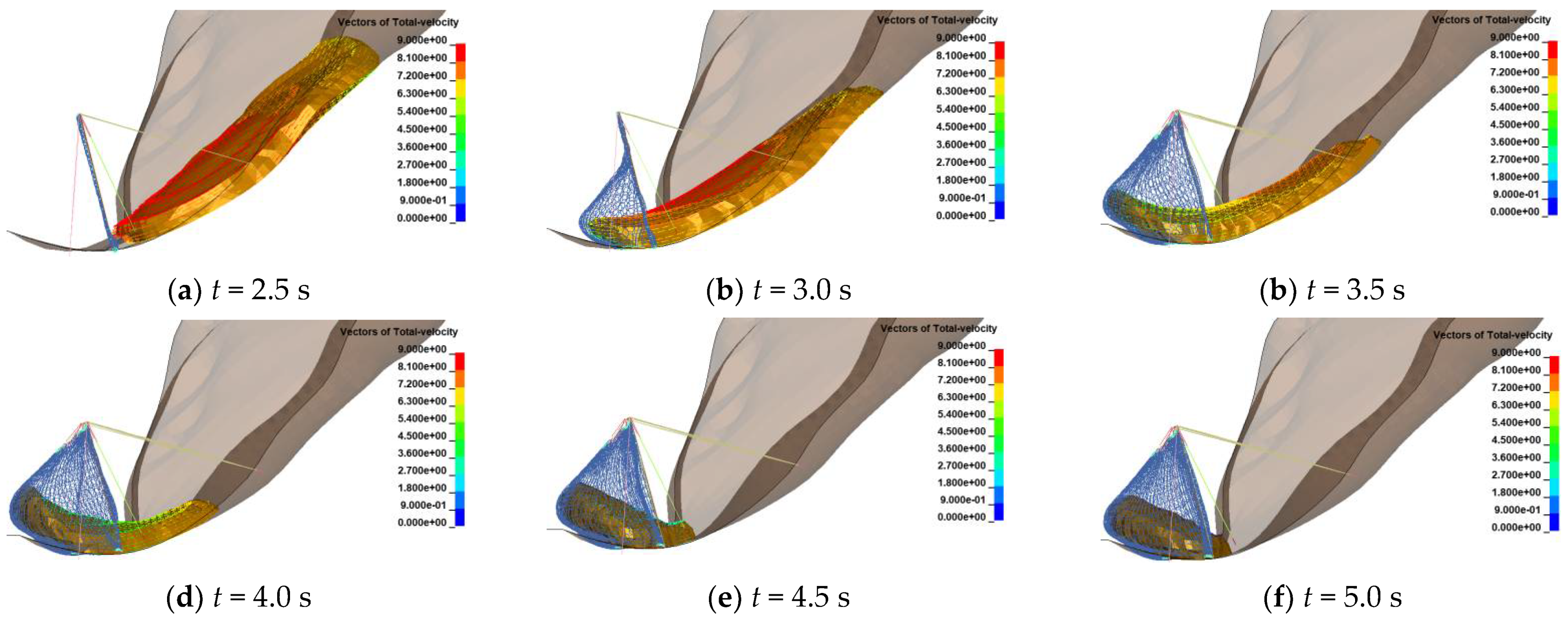


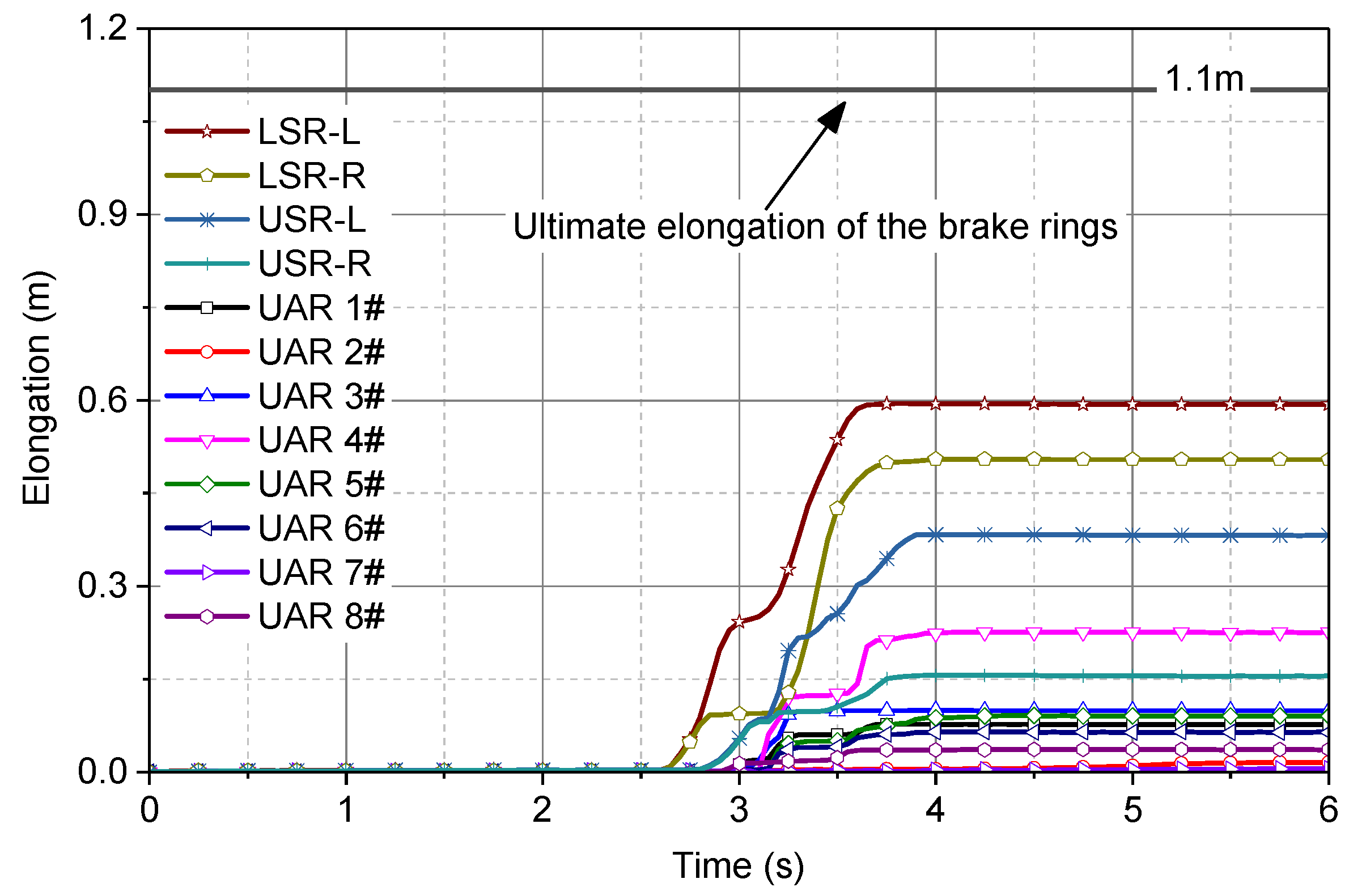
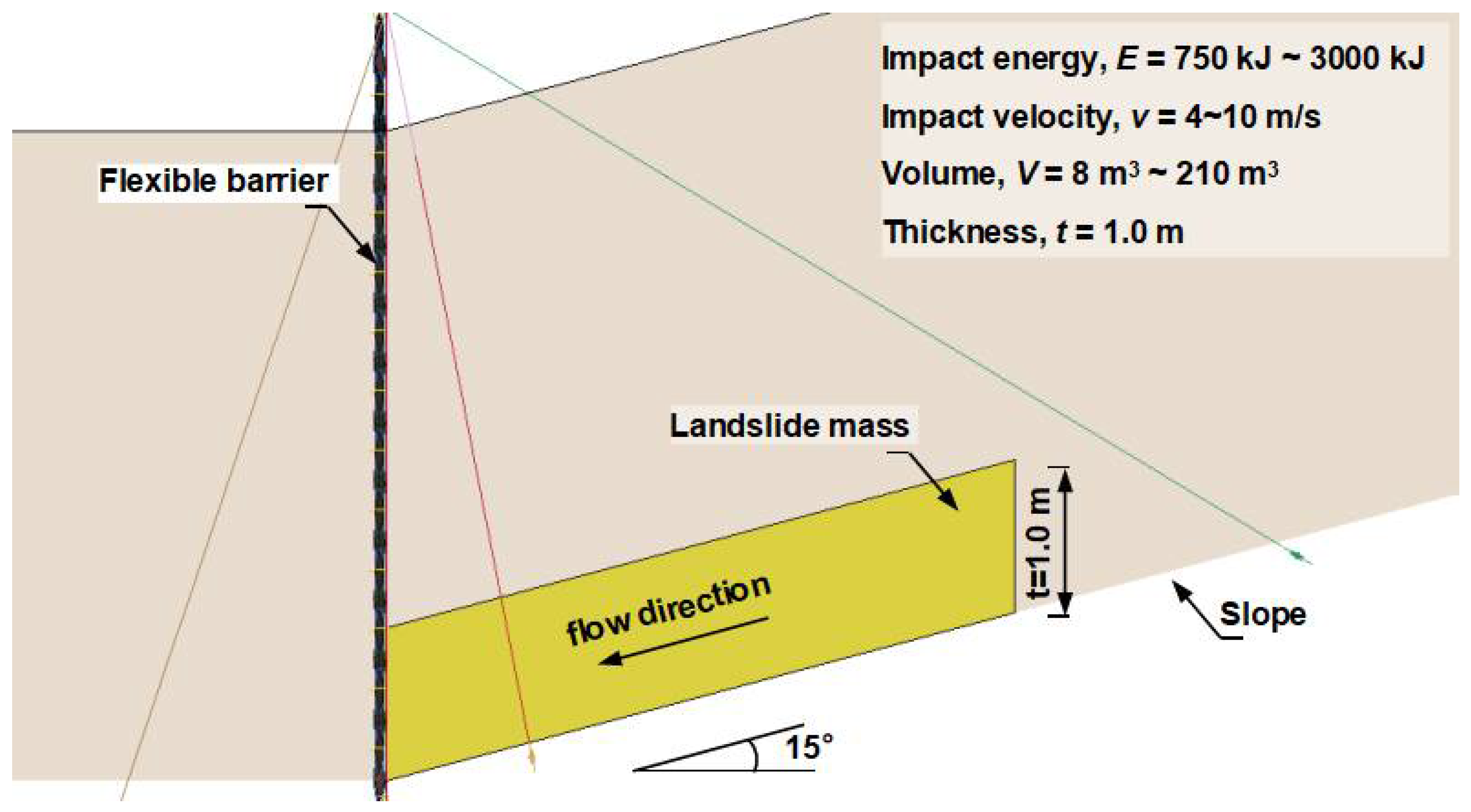
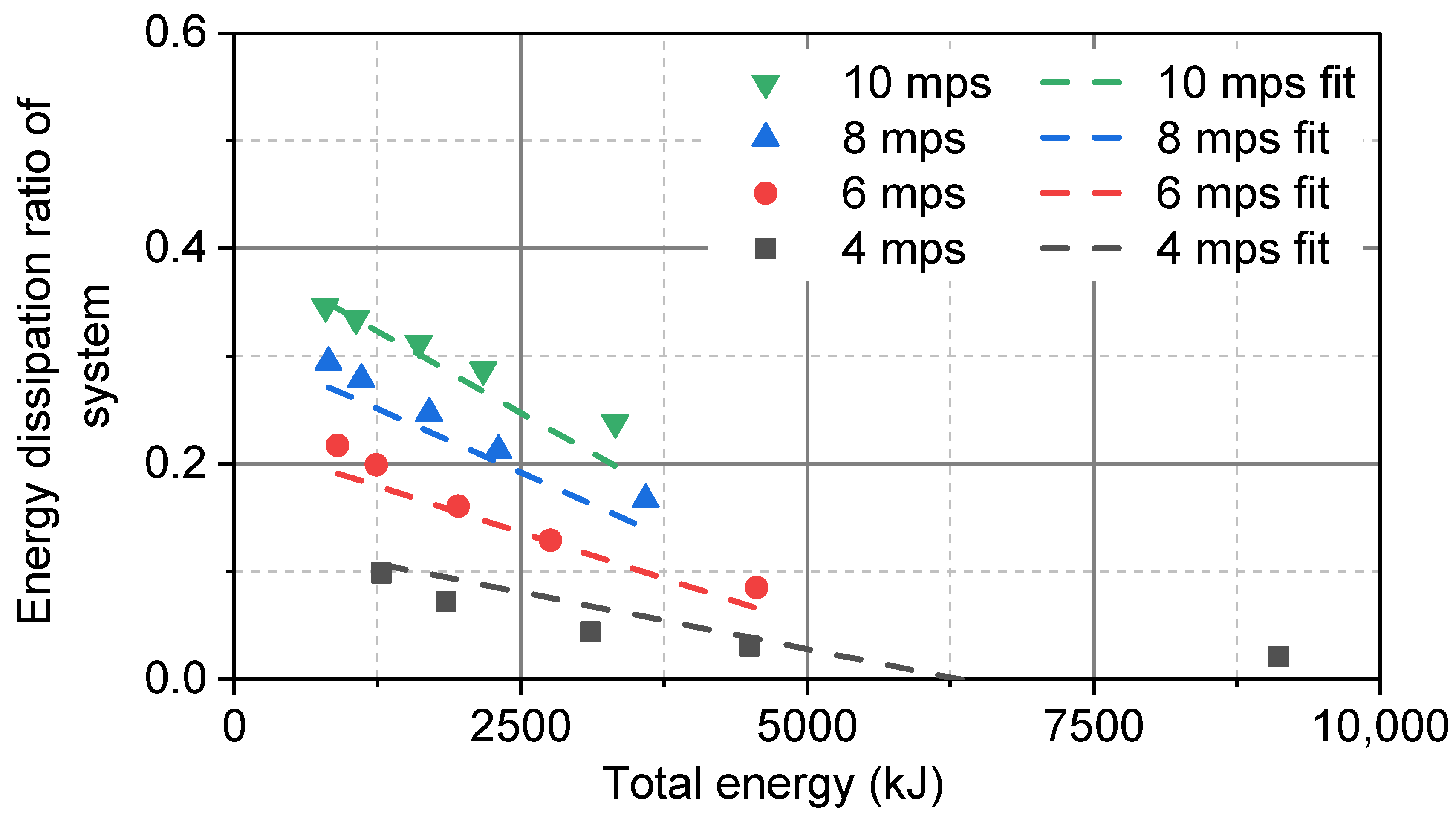



| Material Property | Adopted Value | Remarks |
|---|---|---|
| Density, ρ | 1800 kg/m3 | Roughly measured in the field |
| Internal friction angle, φ | 5° | |
| Shear modulus, G | 500 kPa | By trial-and-error analysis (Evaluated according to the deformation of the barrier) |
| Bulk modulus, K | 1000 kPa | |
| Cohesive strength, c | 2 kPa | |
| Friction coefficient, μ | 0.4 |
| Components | Specification | Modeling Method |
|---|---|---|
| Post | HW 150 × 150 × 6 × 10 (Q235) | Beam elements with plastic kinematic material |
| Steel-wire ring net | R9/3/300 | Beam elements with piecewise linear plastic material |
| Upper support rope | 1 × 24 | Discrete cable element |
| Lower support rope | 1 × 24 | |
| Upslope anchor rope | 1 × 18 | |
| Bypass rope | 1 × 18 | |
| Lateral support rope | 1 × 18 | |
| Lateral anchor rope | 1 × 18 | |
| Energy dissipating device attached to upper/lower support rope | 2 GS-8002 brake rings in parallel | Plastic tension only, translational spring elements |
| Energy dissipating device attached to upslope anchor rope | 1 GS-8002 brake ring |
| Components | Position | Deflection/Elongations (cm) | ||
|---|---|---|---|---|
| Field | Simulation | |||
| Flexible barrier | - | 336 | 352 | |
| Brake rings | Upper support rope (Left/Right) | 0/12 | 4/16 | |
| Lower support rope (Left/Right) | 43/38 | 59/50 | ||
| Upslope anchor rope | 1# | 7 | 8 | |
| 2# | 2 | 2 | ||
| 3# | 9 | 10 | ||
| 4# | 25 | 23 | ||
| 5# | 8 | 9 | ||
| 6# | 7 | 6 | ||
| 7# | 0 | 1 | ||
| 8# | 3 | 4 | ||
| Case No. | Impact Velocity (m/s) | Landslide Volume (m3) | Landslide Mass (kg) | Impact Energy (kJ) | Gravitation Potential Energy (kJ) | Total Energy (kJ) |
|---|---|---|---|---|---|---|
| 1 | 4 | 52.1 | 9.4 × 104 | 750 | 537.1 | 1287.1 |
| 2 | 69.4 | 1.3 × 105 | 1000 | 852.6 | 1852.6 | |
| 3 | 104.2 | 1.9 × 105 | 1500 | 1612.6 | 3112.6 | |
| 4 | 138.9 | 2.5 × 105 | 2000 | 2496.0 | 4496.0 | |
| 5 | 208.3 | 3.8 × 105 | 3000 | 6114.7 | 9114.7 | |
| 6 | 6 | 23.1 | 4.2 × 104 | 750 | 156.1 | 906.1 |
| 7 | 30.9 | 5.6 × 104 | 1000 | 243.8 | 1243.8 | |
| 8 | 46.3 | 8.3 × 104 | 1500 | 458.3 | 1958.3 | |
| 9 | 61.7 | 1.1 × 105 | 2000 | 761.8 | 2761.8 | |
| 10 | 92.6 | 1.7 × 105 | 3000 | 1560.2 | 4560.2 | |
| 11 | 8 | 13.0 | 2.3 × 104 | 750 | 75.9 | 825.9 |
| 12 | 17.4 | 3.1 × 104 | 1000 | 110.4 | 1110.4 | |
| 13 | 26.0 | 4.7 × 104 | 1500 | 205.6 | 1705.6 | |
| 14 | 34.7 | 6.3 × 104 | 2000 | 305.2 | 2305.2 | |
| 15 | 52.1 | 9.4 × 104 | 3000 | 593.6 | 3593.6 | |
| 16 | 10 | 8.3 | 1.5 × 104 | 750 | 46.4 | 796.4 |
| 17 | 11.1 | 2.0 × 104 | 1000 | 65.6 | 1065.6 | |
| 18 | 16.7 | 3.0 × 104 | 1500 | 112.1 | 1612.1 | |
| 19 | 22.2 | 4.0 × 104 | 2000 | 174.1 | 2174.1 | |
| 20 | 33.3 | 6.0 × 104 | 3000 | 330.6 | 3330.6 |
Publisher’s Note: MDPI stays neutral with regard to jurisdictional claims in published maps and institutional affiliations. |
© 2022 by the authors. Licensee MDPI, Basel, Switzerland. This article is an open access article distributed under the terms and conditions of the Creative Commons Attribution (CC BY) license (https://creativecommons.org/licenses/by/4.0/).
Share and Cite
Zhao, L.; Zhang, L.; Yu, Z.; Qi, X.; Xu, H.; Zhang, Y. A Case Study on the Energy Capacity of a Flexible Rockfall Barrier in Resisting Landslide Debris. Forests 2022, 13, 1384. https://doi.org/10.3390/f13091384
Zhao L, Zhang L, Yu Z, Qi X, Xu H, Zhang Y. A Case Study on the Energy Capacity of a Flexible Rockfall Barrier in Resisting Landslide Debris. Forests. 2022; 13(9):1384. https://doi.org/10.3390/f13091384
Chicago/Turabian StyleZhao, Lei, Lijun Zhang, Zhixiang Yu, Xin Qi, Hu Xu, and Yifan Zhang. 2022. "A Case Study on the Energy Capacity of a Flexible Rockfall Barrier in Resisting Landslide Debris" Forests 13, no. 9: 1384. https://doi.org/10.3390/f13091384




